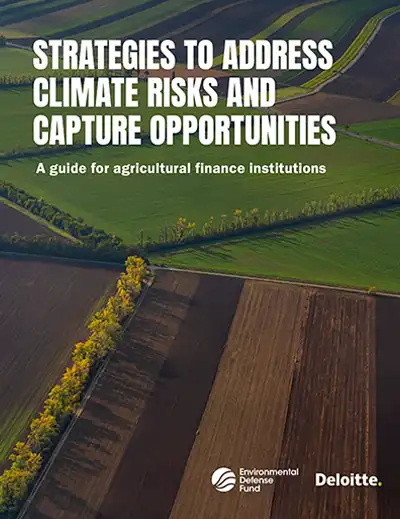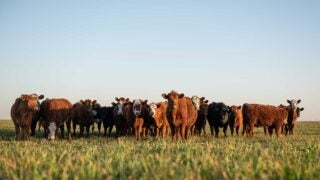- Resources
- Agricultural banks expect climate change to pose financial risks. Here are five strategies to help them adapt.
Resources
Agricultural banks expect climate change to pose financial risks. Here are five strategies to help them adapt.
Published: March 15, 2023 by Vincent Gauthier, EDF | Steve Watkins, Deloitte
Climate change is projected to impact agricultural production worldwide, and 87% of agricultural finance institutions in a recent survey expect it to present risks to their business. Meanwhile, only 24% significantly factor climate change into their decision-making processes.
A new guide from EDF and Deloitte offers five strategies for agricultural finance institutions to manage climate risks and act on climate opportunities. These five strategies integrate climate into agricultural finance institutions’ existing risk frameworks and take a proactive approach to help farmers and ranchers adapt to climate change:
1. Understand business risks presented by climate change.
The first step for integrating climate risks into agricultural finance institutions’ strategies and risk management is to understand how climate change can present business risks. Climate risks can manifest through physical impacts, such as changes in temperature and severe storm intensity, and transition risks such as policy, market and technology changes that occur as the economy acts to reduce GHG emissions.
Climate risks can impact farmers’ and ranchers’ profitability and change portfolio-level risks at the agricultural finance institution. Eighty-three percent of agricultural lenders expect climate change to affect their borrowers’ financial situation. Understanding the climate risks that are projected to occur in their region can help agricultural finance institutions better serve their clients and their evolving financial needs.
2. Conduct a climate risk assessment to project the severity of climate impacts.
Banks and companies worldwide are using climate risk assessments to model the severity of climate impacts on their business. Agricultural finance institutions can implement this approach by working with climate and crop modeling experts to project climate impacts on the profitability and credit risk of their borrowers.
Conducting a climate risk assessment on a segment or the entirety of the loan portfolio can help agricultural finance institutions identify the severity of climate impacts on their borrowers, and the weather or cost changes that could increase financial risks to borrowers. The assessment process can also include evaluating climate solutions that can help farmer borrowers adapt to emerging risks.
3. Establish internal responsibility for climate risks and opportunities to ensure integration across the business.
Integrating the topic of climate risk into existing risk management frameworks and executive-level oversight can help agricultural finance institutions strategically understand, measure and manage climate risks. That process should include identifying the process and responsibilities required to manage climate risks, assigning the responsibilities to a role or department, and documenting results and creating a corresponding reporting structure.
Only 34% of global respondents and 14% of U.S. respondents to the agricultural finance climate survey have employees assigned to climate change issues. This responsibility can be given to existing governance teams and roles, such as the chief risk officer and the board, or can lead to new hires, such as chief sustainability officers.
4. Engage farmers on climate change topics to share information and identify their needs.
Agricultural finance institutions can proactively engage their agricultural customers on climate topics to support them in managing climate risks and opportunities. By engaging customers, loan officers and the institution will better understand their customers’ awareness of climate risks, their specific needs and their level of climate adaptation. Client engagement can help client relationship managers or loan officers provide appropriate financial products and services to their clients.
Developing a client engagement strategy can include providing loan officers with climate risk training and engagement materials. It can also include an information-sharing process and a feedback opportunity for borrowers to share their interests and needs.
5. Develop new and modified products to help borrowers invest in climate adaptation.
Sixty-two percent of respondents in the survey expect increasing demand for new extreme weather-specific financial products, and 46% expect borrowers will have increased credit needs and require new services associated with climate change.
Agricultural finance institutions can support clients’ changing financial needs by offering new or modified financial products that help their agricultural clients manage climate risks or take advantage of climate-related opportunities. Products such as sustainability-linked loans and transition loans can support borrowers in reducing physical and transition climate risks to their operation.
The five strategies presented in EDF’s and Deloitte’s report provide a roadmap for agricultural finance institutions to take the needed action on climate risks to their business and their farmer and rancher borrowers.
Strategies to Address Climate Risks and Capture Opportunities
A guide for agricultural finance institutions.

Our Experts

-
Financial Solutions for Agricultural ResilienceLearn more




